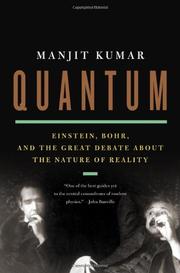

QUANTUM
Einstein, Bohr, and the Great Debate About the Nature of Reality
by Manjit Kumar
A staggering account of the scientific revolution that still challenges our notions of reality.
Wired UK consulting science editor Kumar (Science and the Retreat from Reason, 1997) provides a gripping narrative of the birth of atomic physics in the first half of the 20th century. Max Planck described his 1900 discovery—that light acted on matter in packets of energy rather than continuous waves—as “simply an act of desperation.” Nonetheless, his discovery was an outgrowth of technological problems faced by the burgeoning German lighting industry. In 1905, Albert Einstein, another of the fathers of quantum physics (as well as relativity theory), pointed the way to the discovery of the photoelectric effect and the development of lasers by relating the frequency of light waves to photon energy. However, years later he wrote that quantum physics reminded him “a little of the system of delusions of an exceedingly intelligent paranoic, concocted of incoherent elements of thoughts.” Other puzzling discoveries led Niels Bohr to identify isotopes and to recognize that radioactivity was a fundamentally unpredictable nuclear rather than atomic phenomenon. In 1925, Bohr’s younger associate Werner Heisenberg had a flash of insight that transformed the seemingly paradoxical nature of the new physics and with it called into question the nature of objective reality—it is impossible, he wrote, to achieve a simultaneously exact measurement of quantum physical parameters such as the position and momentum, or the time and energy of a nuclear-scale event. Until his death, Einstein opposed Bohr and Heisenberg’s renunciation of the possibility of representing reality “as independent of observation.” The debate still rages today, spawning new areas of research in quantum computing and even teleportation. Kumar evokes the passion and excitement of the period and writes with sparkling clarity and wit.
Expertly delineates complex scientific issues in nontechnical language, using telling detail to weave together personal, political and scientific elements.